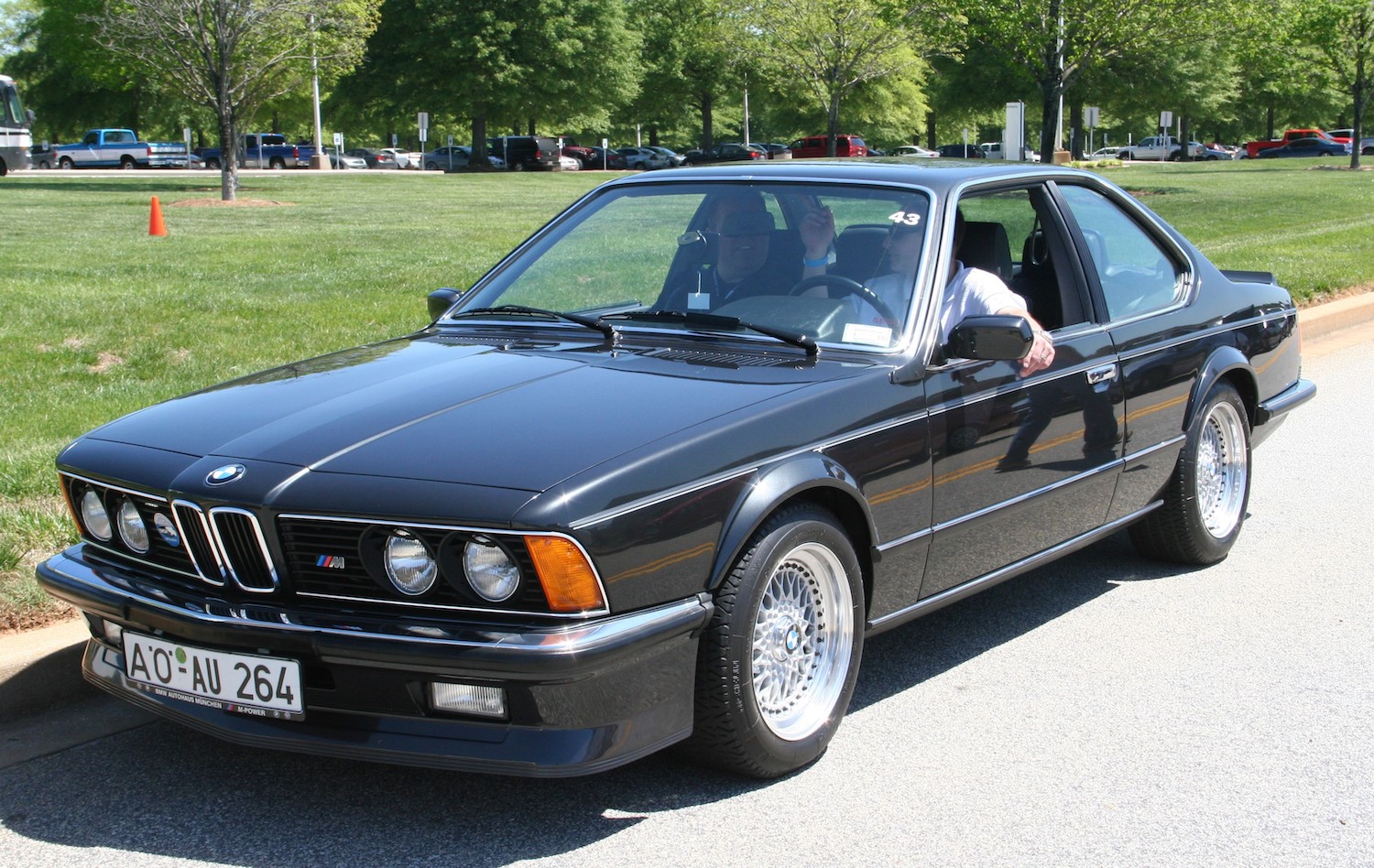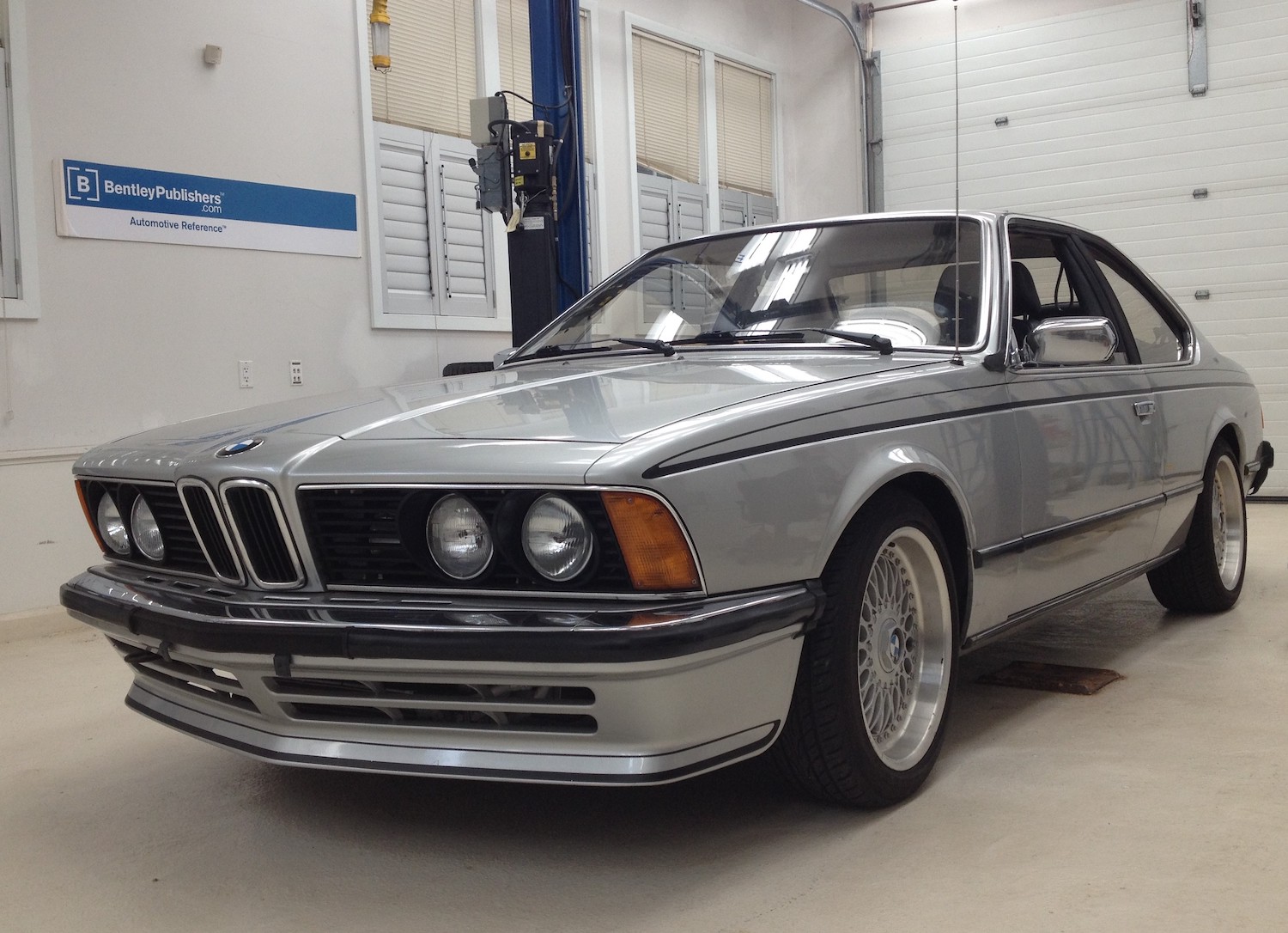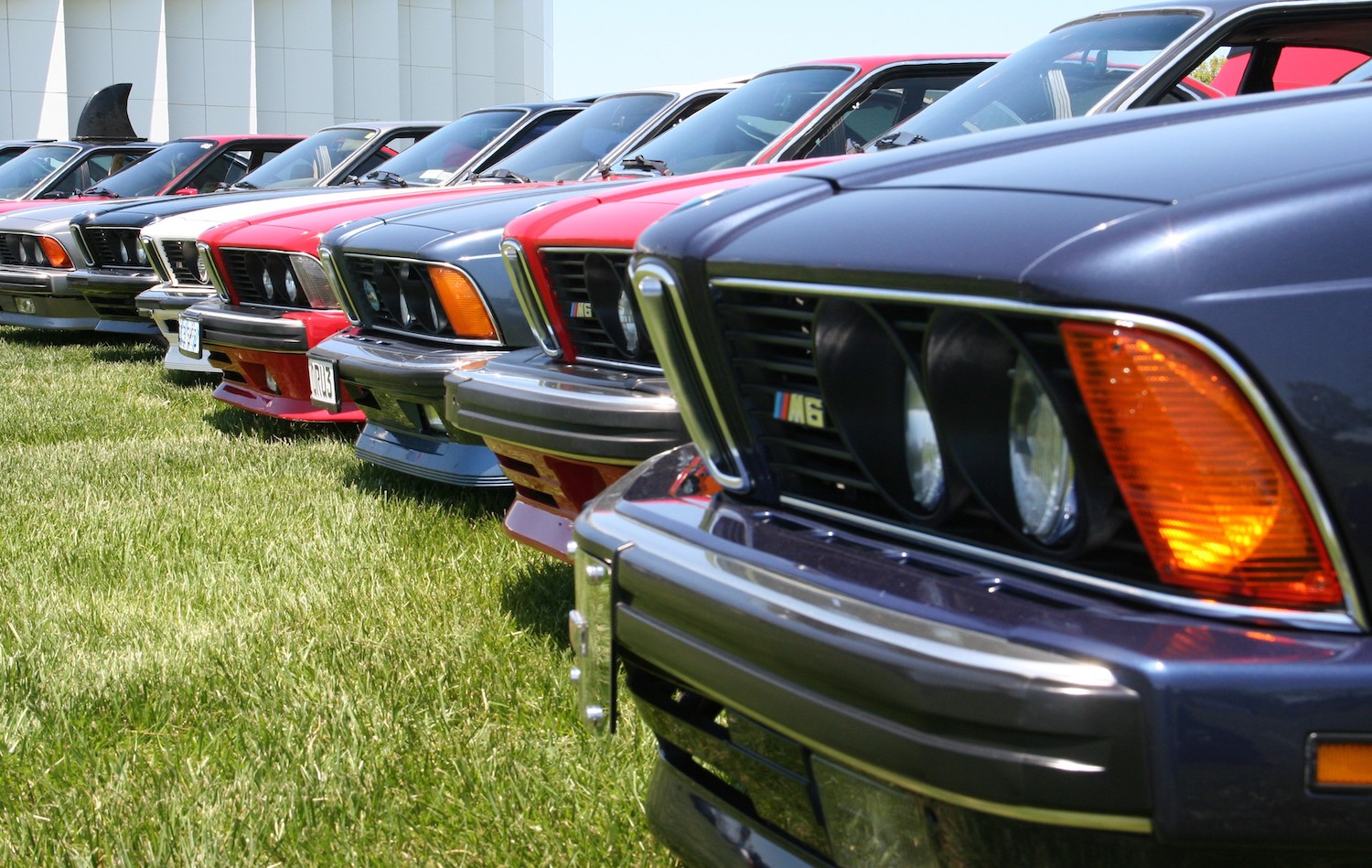The 1976–89 BMW 6 Series Coupe—aka the Shark—still has plenty of bite
BMW’s E30 3 Series and E28 5 Series sedans from the mid- to late-1980s have become appreciating classics. Boxy, purposeful, and iconic, they hearken back to a simpler time when it seemed that BMW could do no wrong and wasn’t trying to make its trademark double-kidney front grilles wide enough to identify from 200 yards away (cruel but true).
The model many people forget about from that same era, however, the one that’s not boxy, is the Shark.
While the term “shark” has been applied to any BMW with an inward-slanting nose panel, including Neue Klasse 1960s sedans, 2002s, E9 coupes, and even early 7 Series cars, it is most often used to describe the big, intimidating 6 Series two-door coupes manufactured from 1976–89. For a while, during BMW’s yuppie years, the 6 Series car seemed synonymous with financial professionals involved in arbitrage, acquisition, and leveraged buyouts, basically threatening to eat alive anything in their path. Perhaps it was only natural that sharks drove Sharks.
The 6 Series coupe, body code E24, was the replacement for the indisputably elegant E9 coupe (1968–76 2800CS, 3.0CS/CSi/CSL). Surprisingly, it became BMW’s longest-lived model, with an incredible 13-year production run. It achieved this trick, however, through a sleight of hand. The E24 was actually based on two different 5 Series cars—the E12 5-series (530i and 528i) through mid-’82, and the E28 5 Series (533i and 535i) thereafter. To the untrained eye, the two iterations look the same, but the exterior difference can be seen in the horizontal crease that runs along the side. On the E12-based cars, this crease is several inches above the front fender lip, whereas on the later E28-based cars, the crease touches the lip, drawing the eye lower and giving the car a slightly more hunkered-down look. The dashboards are also different, with the early cars having three dials in the gauge cluster, the later cars two.

Part of what makes the big coupe intimidating is the length that allows it to have that big, long, flat hood. Even in its most compact Euro-bumpered trim, the car measures in at 15.6 feet through 1986. And those are the small ones. The U.S.-spec versions were as much as 6.5-inches longer due to the DOT-mandated diving-board bumpers. In model year 1988, BMW began using so-called “world bumpers,” bringing the Euro and Federal-spec cars within an inch of each other and the overall length back down below the sweet 16 line.

Many fans of the E28 5 Series sedan don’t really like the 6 Series coupe, arguing that the extra length doesn’t buy you anything. After all, the 5 Series sedan was, at that time, the fastest four-door sedan sold in North American and had a real back seat. Why give up that purposeful design for something that’s bigger, slower, doesn’t handle as crisply, and can barely hold two watermelons in the back?
As with many things, it depends on what you want. To me, the 6 Series coupe is about presence. The Paul Bracq-penned design, especially the Euro cars bereft of the big bumpers, looks like nothing else (which is funny because, at the time, it was basically stolen and reused in the 10th-generation 1989 Ford Thunderbird). It may be a stretch to say that it’s a unique and pure shape in the way that an E-Type or a C2 Corvette is a unique and pure shape, but it certainly is dramatic.
In terms of performance, you have to remember this was the ’70s and ’80s. Germany kept its best at home. The U.S.-spec cars were still finding their footing after EPA dropped the hammer on smog in 1975. While Europe got the catalytic-converter-free 218-horsepower 635CSi, with its M90 motor and dogleg close-ratio five-speed, we initially received the 176-hp 630CSi, powered by the same L-Jetronic-equipped engine as the E12 530i and the same thermal reactors integrated with the exhaust manifold that caused the head to crack. This gave way, in 1978, to the 633CSi (L-Jet with a mechanical advance distributor and a traditional catalytic converter). Along with the switch to the E28 chassis in 1982 came a Motronic 3.2 engine with computer-controlled injection and spark advance (the same engine as in the E28 533i). The U.S.-spec 635CSi appeared in 1985, but it was still a shadow of its Teutonic namesake. Finally, for 1988, the power gap largely closed, with the Federal car getting the M30B35 engine with power was up to 208 horses.
In 1984, BMW unveiled the delicious M635CSi, built with a 286-hp version of the 24-valve M88 motor from the legendary BMW M1. But all us Yanks could do was drool—or import one and federalize it. Finally, in 1987, the U.S. got its own version, the M6, which uses a catalyst-equipped 256-hp, 24-valve S38 motor (the same engine as the E28 M5). Note that the 1987 M6s still have the big bumpers, whereas the ’88s have the slimmer “world bumpers.”

Rust
Though E24s don’t spontaneously dissolve like their predecessor, the E9 coupe, they are not immune to the tin worm, so finding a solid one is key to a happy long-term relationship. Fortunately, they don’t squirrel rust away in difficult-to-see places to the same extent as the E9; what you see is pretty much what you get. Front and rear shock towers, wheel arches, rockers, fender bottoms, and floor pans are common rust-through places.
Mechanical problem areas
Because E24s share so much running gear with the 5 Series, the cost of most mechanical parts is fairly reasonable, though 6 Series-specific trim, interior parts, and body panels are becoming scarce. The M30 motor is practically bullet-proof (and ubiquitous—BMW used it for 28 years), but its Achilles heel is that it’s a straight six; overheat it once and that long, straight aluminum head can warp or crack. Thus, the most important maintenance is cooling system related—radiator, water pump, thermostat, expansion tank, hoses, fan (so, yeah, everything). Another more subtle issue is wear on the front cam lobes. There’s an oil distribution tube sprays oil on the cam, secured to the head with two banjo bolts. If they loosen up, oil will flow out the base of the bolts instead of pushing through the distribution tube. Since the tube is fed oil from the back of the head, if the bolts loosen, it’s the front cam lobes that don’t get oiled. If there’s any rough-running issue, pulling the valve cover for a visual inspection of the valve train is advised. But most of the rest of the issues are the vagaries one expects of any 35-year-old car.

Later 635s and the M6 came with TRX wheels and tires, Michelin’s short-lived metric-sized rubber entry into the tire version of the VHS/Betamax war. I strongly recommend buying a car that comes with a set of these because it gives you the perfect justification to throw them in the trash and buy a set of 17-inch BBS RC090s from a BMW E39 5 Series, which look absolutely spectacular on any Shark. Just be sure to also buy the 72.56mm-to-74.1mm hub-centric rings to fit them properly.
Which model to buy
Here is the general hierarchy of lust and value:
- The M635CSi in full-on original Euro trim, with the correct unfederalized cat-less M88 engine and bundle-of-snakes header, is often deemed the most desirable E24. There were only 3283 LHD cars built for the Euro market. If you find one here in the States, it’s likely a gray market car, so it’s best to know whether it was federalized, and if so, how.
- The M635CSi is followed closely by its American fraternal twin, the S38-powered M6. With only 1632 U.S.-spec M6s (750 of the bigger-bumpered cars in 1987, the rest world-bumpered 1988 cars), it’s certainly a low-production car. For years the M6 lagged inexplicably behind the E28 M5 in value, but that’s changed; asking prices for pristine low-mileage M6s now reach the mid-40s. The days of driver-quality M6s in the low teens appear to be over.
- The 1978–81 European 635CSis with the small Euro bumpers, the correct 218-hp M90 engine, and the dogleg close-ratio gearbox, raise many an enthusiast’s pulse rates (and, when wearing gray paint and adorned with trunk and chin spoilers, do look more than a bit cartilaginous). However, rust tends to be a greater problem on these early cars than on the later E28-based cars, so be sure to check the body thoroughly.
- Then you’re into the U.S.-spec non-M cars. On paper, the 1988–89 cars are the sweet spot of price, performance, appearance, and availability, with the “world bumpers” and 208-hp M30B35 engine, readily available in the $5K–$15K range. Unfortunately, by this point, the U.S. received only what in Europe is called the “Highline” option. Almost all those brought here were automatics; only 246 635s were imported in ’88–89 with a five-speed. Plus, by 1988, the sport seating option had been discontinued (BMW decided that, if you wanted a stick and sport seats, you needed to buy an M6). And these late cars are heavier and more complex, equipped with a rear self-leveling suspension, even fitted with a rear console containing a beverage cooler and rear A/C (in a back seat that no one ever sat in. Go figure.)
- In contrast, the 1985–87 635CSis with the diving board bumpers and the 182-hp engine are more plentiful, less expensive, simpler, lighter, and are much easier to find with a stick and sport seats. So, for a bargain fun driver 6 Series coupe, this is where many folks wind up.
- Bringing up the rear is the 633CSi. Note that that badge is worn by two different versions—the last E12-based L-Jetronic car with a conventional mechanical advance distributor, and the first E24-based Motronic car.
Unless you find an unfederalized early Euro car, the later E28-based cars generally make the most sense. They all have ABS, the post-’85 cars have air bags, Motronics is generally preferable to L-Jet for reliability and drivability, they’re less rust-prone, and parts are a bit easier to find. The tradeoff is that they’re heavier and a bit more complex, but nothing compared with a post-OBD-II BMW.
Beyond the model-by-model taxonomy, there’s the issue of—and I absolutely hate using the word, but there’s no getting around it—stance. While all E24s have presence, there’s something magical that happens when they’ve got front and rear air dams, fat rubber, and a settled suspension. Add short Euro bumpers, factory striping, and the right wheels, and the car practically exudes pheromones. So, if you see a U.S.-spec 633CSi without any of these things and think “meh,” but swoon at the sight of an M6, that’s a lot of what you’re reacting to.

Me? Nothing gets me jazzed like an early Euro E12-based 635CSi with the close-in bumpers. The lines are so much cleaner than the U.S. version that it almost looks like a different car. And the factory stripes which continue on the front air dam do a neat visual trick of making the car look even more hunkered down. My ’79 Euro has a U.S.-spec M30 engine instead of the correct M90, and it lost its dogleg five-speed sometime in the distant past—and it has 212,000 miles on it—but I don’t care, because those short bumpers, air dam, and stripes just send me to the moon whenever I look at it. And isn’t that what buying any vintage car is about?

E24s present an opportunity to get into a dramatic two-door BMW coupe without risking the kids’ tuition money. Many folks will still opt for the BMW E30 3 Series instead due to its compact size, tossable handling, and iconic ’80s movie cameos, but the 6 Series carves corners just fine, effortlessly inhales interstate, and is simply way cooler.
Be a shark. It’s the shape of things to come.

***
Rob Siegel has been writing the column The Hack Mechanic™ for BMW CCA Roundel magazine for 34 years and is the author of five automotive books. His new book, Resurrecting Bertha: Buying back our wedding car after 26 years in storage, is available on Amazon, as are his other books, like Ran When Parked. You can order personally inscribed copies here.


I’ve owned several E24s over the years. They were an affordable way into BMW collecting but that has pretty much disappeared with prices rising sharply right after I sold my last one a few years back (’88 5spd) . There’s lots to love in all 6ers. Most people have dumped the TRX wheels/tires that came on these and that’s a good thing One car I still regret not buying was an ’85 red Euro 635CSi 5spd with all the controls labeled in Italian .
I may be a little different but I actually prefer the cleaner lines of the earlier E24’s without the boy racer look of the front and rear spoilers. These cars being designed in a stylist studio before BMW even owned a wind tunnel were aero bricks so its unlikely the add on spoilers made all that much difference at normal driving speeds. Guess beauty lies in the eye of the beholder however.